Example, Solution | Algebra - System of Linear Equations in Three Variables | 10th Mathematics : UNIT 3 : Algebra
Chapter: 10th Mathematics : UNIT 3 : Algebra
System of Linear Equations in Three Variables
Simultaneous Linear Equations in Three Variables
Right from the primitive
needs of calculating amount spent for various items in a super market, finding
ages of people under specific conditions, finding path of an object when it is
thrown upwards at an angle, Algebra plays a vital role in our daily life.
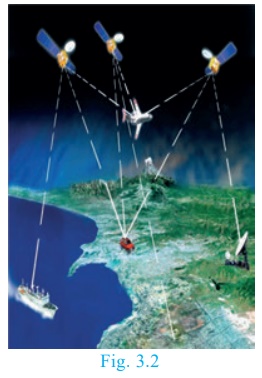
Any point in the space
can be determined uniquely by knowing its latitude, longitude and altitude.
Hence to locate the position of an object at a particular place situated on the
Earth, three satellites are positioned to arrive three equations. Among these
three equations, we get two linear equations and one quadratic (second degree)
equation. Hence we can solve for the variables latitude, longitude and altitude
to uniquely fix the position of any object at a given point of time. This is
the basis of
Geo-Positioning System (GPS). Hence the concept of linear equations in three variables is used in GPS systems.
System of Linear Equations in Three Variables
In earlier classes, we
have learnt different methods of solving Simultaneous Linear Equations in two variables. Here
we shall learn to solve the system of linear equations in three variables
namely, x, y and z. The general form of a linear equation in
three variables x, y and z is ax + by +cz +
d = 0 where a, b, c, d are real numbers, and atleast
one of a, b, c is non-zero.
Note
A linear equation in
two variables of the form ax + by +c = 0 ,
represents a straight line .
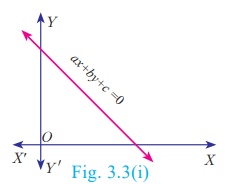
A linear equation in
three variables of the form ax + by +cz + d = 0 ,
represents a plane.
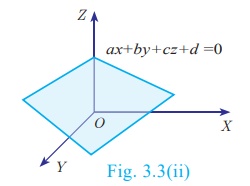
General Form: A system of linear
equations in three variables x, y, z has the general form
a1x + b1y
+c1z + d1 = 0
a2 x + b2y
+c2 z + d 2 = 0
a3 x + b3y
+c3 z + d 3 = 0
Each equation in the
system represents a plane in three dimensional space and solution of the system
of equations is precisely the point of intersection of the three planes defined
by the three linear equations of the system. The system may have only one
solution, infinitely many solutions or no solution depending on how the planes
intersect one another.
The figures presented
below illustrate each of these possibilities
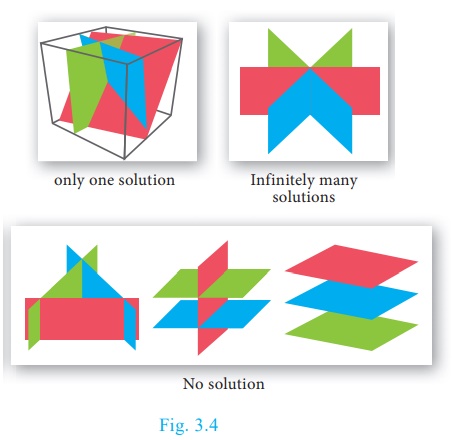
Procedure for solving system of linear equations in three variables
Step 1 By taking any two
equations from the given three, first multiply by some suitable non-zero
constant to make the co-efficient of one variable (either x or y or z)
numerically equal.
Step 2 Eliminate one of the
variables whose co-efficients are numerically equal from the equations.
Step 3 Eliminate the same
variable from another pair.
Step 4 Now we have two
equations in two variables.
Step 5 Solve them using any
method studied in earlier classes.
Step 6 The remaining variable
is then found by substituting in any one of the given equations.
Note
·
If you obtain a false equation such as 0=1, in any of the steps
then the system has no solution.
·
If you do not obtain a false solution, but obtain an identity,
such as 0=0 then the system has infinitely many solutions.
Example 3.3
Solve the
following system of linear equations in three variables
3x – 2y + z
=2 , 2x + 3y – z = 5 , x + y + z = 6
.
Solution
3x − 2y + z
= 2
…(1)
2x + 3y – z
= 5
…(2)
x + y + z =
6
…(3)

Substituting x =
1 in (4), 5 + y = 7
gives, y = 2
Substituting x = 1 , y
= 2 in (3),
1 + 2 + z = 6 we get, z = 3
Therefore, x = 1,
y = 2 , z = 3
Example 3.4
In an interschool
atheletic meet, with 24 individual events, securing a total of 56 points, a first
place secures 5 points, a second place secures 3 points, and a third place
secures 1 point. Having as many third place finishers as first and second place
finishers, find how many athletes finished in each place.
Solution
Let the number of I, II
and III place finishers be x , y and z respectively.
Total number of events =
24; Total number of points = 56.
Hence, the linear
equations in three variables are
x + y + z =
24 …(1)
5x + 3y + z
= 56 …(2)
x + y = z …(3)
Substituting (3) in (1) we get, z + z = 24 gives, z = 12
Therefore, (3) equation will be, , x + y = 12

Substituting x =
4 , z = 12 in (3) we get, y = 12 − 4 = 8
Therefore, Number of
first place finishers is 4
Number of second place
finishers is 8
Number of third place
finishers is 12.
Example 3.5
Solve x + 2y
– z = 5 ; x − y + z = −2 ; − 5x − 4y
+ z = −11
Solution
Let, x + 2y – z =5 …(1)
x – y + z =–2 …(2)
x – y + z =–2 …(2)
–5x –4y + z = –11 …(3)

Here we arrive at an
identity 0=0.
Hence the system has an
infinite number of solutions.
Example 3.6
Solve 3x + y
– 3z = 1 ; –2x – y + 2z = 1 ; –x – y
+ z = 2 .
Solution
Let
3x + y − 3z
= 1 … (1)
− 2x −y +
2z = 1 … (2)
−x − y + z
= 2 … (3)
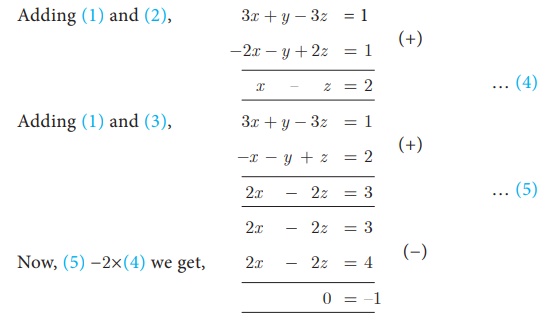
Here we arrive at a
contradiction as 0 ≠ –1.
This means that the
system is inconsistent and has no solution.
Example 3.7
Solve 
Solution
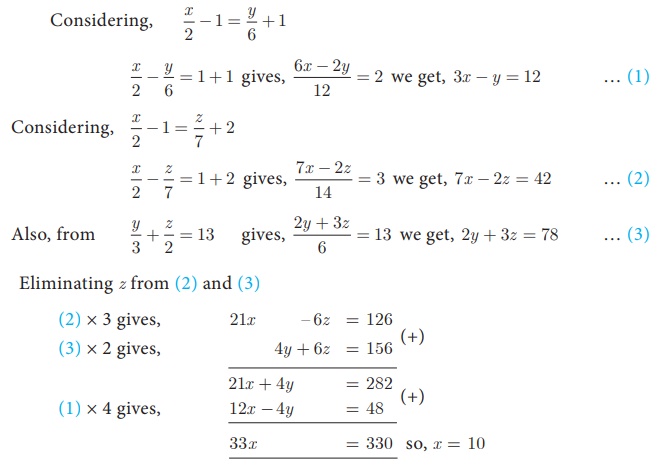
Substituting x =
10 in (1), 30 − y = 12 we
get, y = 18
Substituting x =
10 in (2), 70 − 2z = 42
then, z = 14
Therefore, x = 10
, y = 18 , z = 14.
Example 3.8
Solve : 
Solution
Let 
The given equations are
written as
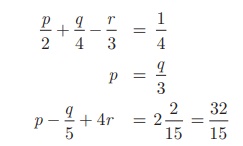
By simplifying we get,
6p + 3q −
4r = 3
…(1)
3 p = q
…(2)
15p − 3q +
60r = 32 …(3)
Substituting (2) in (1) and (3) we get,
15p - 4r =
3 …(4)
6p + 60r =
32 reduces to 3p + 30r = 16 …(5)
Solving (4) and (5),
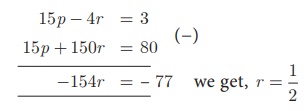
Substituting r = 1/2
in (4) we get, 15p - 2
= 3 gives, p = 1/3
From (2), q = 3p
we get q = 1
Therefore, x = 1/p = 3, y = 1/q = 1, z = 1/r = 2 . That is, x = 3, y = 1, z = 2 .
Example 3.9
The sum of thrice the
first number, second number and twice the third number is 5. If thrice
the second number is subtracted from the sum of first number and thrice the
third we get 2. If the third number is subtracted from the sum of twice the first,
thrice the second, we get 1. Find the numbers.
Solution Let the three numbers be x, y, z
From the given data we
get the following equations,
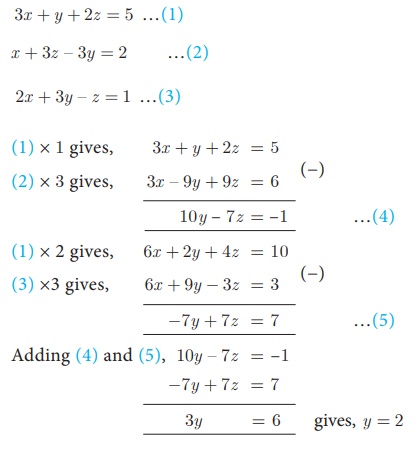
Substituting
y = 2 in (5),− 14 + 7z = 7 gives,z = 3
Substituting
y = 2 and z = 3 in (1),
3x + 2 + 6 = 5 we get x =
−1
Therefore,
x = –1, y = 2, z = 3.
Progress Check
1. For a system of
linear equations in three variables the minimum number of equations required to
get unique solution is _______.
2. A system with
_______ will reduce to identity.
3. A system with
_______ will provide absurd equation.
Related Topics